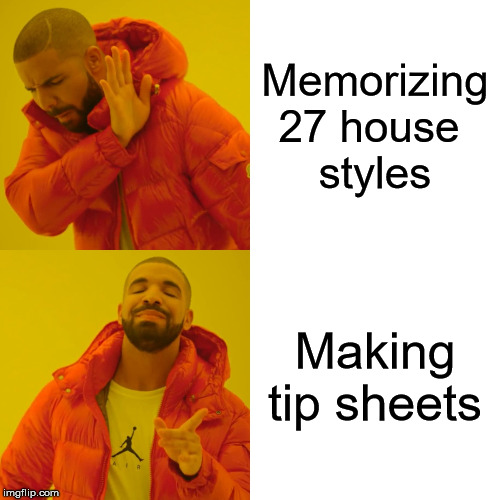If you’re a lucky proofreader, you’ll work for a company that has one house editorial style. Singular. Not so much here at MarketReach.
Sure, we have our own MarketReach style that we apply to our own internal and marketing writing. But we also work for many different companies, each with its own style.
One style guide? Hah! Try 27.
Currently, we juggle 27 different editorial style guides—some of them more than 200 pages long. In total, that’s more than 1,300 pages of editorial goodness.
I’ve always been a word nerd, so I enjoy the challenge of following different rules for different clients. Though I will say it is tough to switch gears quickly and work on a style that is the antithesis of what you were just working on.
So how do I keep all those different styles straight? Two words: tip sheets.

Credit: Drake, "Hotline Bling" music video.
Great. So, what’s in a tip sheet?
A tip sheet is basically a list of common topics that you must refer to even before starting the editing process.
When I get a project, the first thing I do is open up the style tip sheet for that company and glance through it. The tip sheets are usually around a page each, as opposed to the behemoth guides from the client.
I can always pull up the full guide if I need it. But with a well-made tip sheet to refer to, I rarely have to.
The three most important topics on my tip sheets are:
- Capitalization (when to use sentence case or initial caps)
- The use (or lack thereof) of the serial comma
- Copyright and trademark usage
I make sure this information is at the very top of every tip sheet.
The rest of the tip sheet includes repetitious nitpicky things—for example, how to treat numbers (spelling out one through nine, comma starting with 1,000 or 10,000), time (a.m., am, A.M., or AM), whether the client hyphenates “hyperconverged,” or if they use a space before and after an em dash.
This section also includes any personal client preferences that may contradict the style identified in the larger corporate guide. For example, some clients prefer the American format for dates (month day, year) to the international style (day month year) identified in the company guide.
Tip sheets are your friend! Yes, following 27 style guides can be daunting, but it’s completely doable. So open up a Word doc and make your own tip sheet for your guide!